Ontology-Mediated Historical Data Modeling: Theoretical and Practical Tools for an Integrated Construction of the Past
Abstract
1. Introduction
- Available tools allow us to deal with massive datasets, some of which were disregarded until recently as marginal or non-significant.
- Interdisciplinary teamwork is key to build a richer, fairer and more precise construction of the past.
- Information sources of diverse origin and nature must be integrated within a cross-disciplinary perspective.
- Open datasets become compulsory within a new research Open Science framework.
2. State-of-the-Art: Constructed Past Theory and Theoretical Approaches from Archaeology and Record Management
3. Underpinning Ontological Concepts and Data Modeling: The Methodological Basis of RIS
3.1. Definition of Minimum Information Units: Conceptual Data Modeling
- Unit of Topography (UT): It is the evidence of an action or situation that can be located in space and time, regardless of the specificity of the information source and its biotic, non-biotic or anthropic origin. Each UT has a specific location and date. Location can be expressed as a UTM coordinate or as an administrative delimitation that might have changed during history. Some UT examples are the existence of a vegetal specimen in a determined area; the consecration of a church; the transaction of a property; the existence of a necropolis; the remains of a pathway, a birth, a marriage, a death or a burial, etc.
- Actor (Ac): It is the individual or corporative, active or passive, protagonist of an action identified as a UT. If being an individual, their attributes are their name, gender, religion, citizenship, date of birth and death, etc. Different individual actors gathered for a given period of time with a particular purpose and under determined conditions can act as corporative actors. In CPT’s terms, Actors should be considered Entities, while UTs could be Entities or Events.
- Value (V): Expressed as a price or a size magnitude, it is a mechanism. Through the value of something, the Actor makes the UT possible.
- Date (D): It is the specific time when the event happened. If the entity is related to permanence and the event relates to change, at least one entity has to be involved in an event [1] (p. 7), and date is a component of an event or a process. We can identify as a date an exact point in time, a period before an exact point or after it, or a period between two exact points.
- UT–UT: A UT can include, link or delimitate another UT. Hence, Inclusion, Delimitation, and Link are classes of the UT–UT relationship.
- Ac–UT: This relationship is expressed as the active/passive role the Actor plays within a UT.
- Ac–Ac: Any familial, political, social or economic relationship identified between actors is a condition for events to happen and entities to transform. Through this relationship, individual actors can join into corporative actors forming then new entities.
- Va–UT: This relation expresses the price or size of a UT.
- Ac–Va: The use of this value by the actor—as expressed in this class of relationship—is the mechanism to create a new UT.
3.2. Units of Topography and Units of Stratigraphy: Towards an Archaeological RIS
4. Results: Experiences of Past Construction and Tool Development
4.1. Archaeological Information System: Classification Chart as File Management Tool
- Descriptive dimension: US description includes information about its class (deposit, structure or interface), definition (e.g., layer, wall, hole, etc.), natural or anthropic origin, and interpretation (e.g., construction, destruction, use, erosion).
- Graphic dimension: Photographic register records the graphic dimension of US through different pictures (aerial, general, detail) that are stored and identified through normalized metadata.
- Cartographic dimension: As stated in archaeological method, a single-layer plan for every US records the basic cartographic data by means of drawing the boundary contours of the US, and placing some evenly distributed elevations on the plotted area [35] (pp. 95–104).
- Temporal dimension: Defining the stratigraphic sequence is the way to record the temporal dimension of the US, according to the physical relation between them [35] (pp. 34–39).
4.2. GIS and Archaeology. SigArq Tool Development
- US definition: US identification requires briefly defining what it is/was according to the materiality of the remains. A few examples of short definition are wall, filling, levelling layer, silo, pit, landslide, tomb, individual within a burial, etc.
- Form Completion: Once the US is identified and defined, users are allowed to record US descriptive and temporal dimensions within a form. Although Description, Composition, and Interpretation are free-text entry input fields, fundamental attributes such as Origin or Type of US amongst others are single-choice input fields controlled through thesauri. Within the US form, the temporal dimension is introduced by means of recording the physical relation between the US under examination and those below. System crosscheck returns the relations with the US above and verifies the non-existence of contradictions in the stratigraphic sequence through a green-shaded status field. If contradictory data are introduced, they will be highlighted in red.
- File uploading: General and detailed pictures of each US, identified with metadata—as shown in Table 2—and stored in the adequate ARIS-series, attest the US graphic dimension. In this step, one selected picture file is uploaded into the application together with an XYZ-coordinate capture table.
- Cartography production: The cartographic dimension is the last item recorded within the system. The previously uploaded XYZ-table is now used to produce the plan and elevation, reproducing the cartography of the US within the general excavation plan.
- US Metrics and exploitation: Like any SIG software, SigArq has some enabled geometric functions that calculate US total surface, point out distance and any other metrics desired for exploitation.
5. Discussion: Past Construction through UT/US Dialectics
6. Future Prospective
Author Contributions
Funding
Acknowledgments
Conflicts of Interest
Appendix A
| Vestige | UT Id | UT Brief Description | Relationship(s) | Location | Biotic At | Anthropic At | Date |
|---|---|---|---|---|---|---|---|
| Example A1 | 01 | Purchase | V1 (price) | = UT05 | Fact, transaction | D1 | |
| Example A1 | 02 | Land, vineyard, trees | Included in: UT05 Includes: UT12, 13, 14 Altered by UT01 | = UT05 | Property Activity: farming | D1 | |
| Example A1 | 03 | County of Barcelona | Includes: UT04 | Barcelona | Landscape: Place name | D1 | |
| Example A1 | 04 | Municipality of Terrassa | Included in: UT03 Includes: UT05 | Terrassa | Landscape: Place name | D1 | |
| Example A1 | 05 | Place Montagut | Included in: UT04 Includes: UT2 | UTM 31T x: 41582; y: 4599521 | Landscape: Place name | D1 | |
| Example A1 | 06 | Aregall | Delimitation (E): UT02 | = UT04 | Landsc.: Place name | D1 | |
| Example A1 | 07 | Land | Delimitation (E): UT02 Owned by: Ac04, 05 | = UT04 | Property | D1 | |
| Example A1 | 08 | Land | Delimitation (S): UT02 Owned by: Ac06 | = UT04 | Property | D1 | |
| Example A1 | 09 | Via | Delimitation (W): UT02 | = UT04 | Road network: via | D1 | |
| Example A1 | 10 | Land | Delimitation (W): UT02 Owned by: Ac03 | = UT04 | Property | D1 | |
| Example A1 | 11 | Land | Delimitation (N): UT02 Owned by: Ac09 | = UT04 | Property | D1 | |
| Example A1 | 12 | Fig trees | Altered by: UT01 | = UT05 | Flora, Fig | Activity: farming | D1 |
| Example A1 | 13 | Plum trees | Altered by: UT01 | = UT05 | Flora, Plum | Activity: farming | D1 |
| Example A1 | 14 | Vineyard | Altered by: UT01 | = UT05 | Flora, Vine | Activity: Wine prod. | D1 |
| Example A1 | 15 | Walnut trees | Altered by: UT01 | = UT05 | Flora, Walnut | Activity: farming | D1 |
| Example A1 | 16 | Fish farm | Altered by: UT01 | = UT05 | Fauna, Fish | Activity: fish farming | D1 |
| Example A1 | 17 | Acorn trees | Altered by: UT01 | = UT05 | Flora, Acorn | Activity: farming | D1 |
| Example A1 | 18 | Olive trees | Altered by: UT01 | = UT05 | Flora, Olive | Activity: Oil prod. | D1 |
| Example A1 | 19 | Purchase scripture | Altered by: UT01 | = UT05 | Activity: Scripture | D1 | |
| Example A2 | 20 | Debt | Ac14&Ac15 to Ac13 | = UT27 | Activity: transaction | D2 | |
| Example A2 | 21 | First letter of exchange | Ac14&Ac15 received from Ac16& Ac17 | = UT22 | Activity: transaction | D4 | |
| Example A2 | 22 | Venice | Location UT21, 23, 25, 26 | Venice | Activity: transaction | D3 | |
| Example A2 | 23 | Loan | Ac18&Ac19 paid to Ac16& Ac17 | = UT22 | Activity: transaction | D3 | |
| Example A2 | 24 | Debt | Ac20 to Ac13 | = UT27 | Activity: transaction | D5 | |
| Example A2 | 25 | Third letter of exchange | Ac20 received from Ac16& Ac17 | = UT22 | Activity: transaction | D7 | |
| Example A2 | 26 | Loan | Ac18&Ac19 paid to Ac16& Ac17 | = UT22 | Activity: transaction | D6 | |
| Example A2 | 27 | City of Barcelona | Included in: UT03 | Barcelona | Landscape: Place name | D2&D5 |
| Vestige | Ac Id | Name | Job | Gender | Relationship(s) |
|---|---|---|---|---|---|
| Example A1 | 01 | Semplizia | unknown | Female | Ac-UT: Seller UT02; Signature UT19/Ac-Ac: Sibling Ac02 |
| Example A1 | 02 | Cixolo | unknown | Female | Ac-UT: Seller UT02; Signature UT19/Ac-Ac: Sibling Ac01 |
| Example A1 | 03 | Guilara | Priest | Male | Ac-UT: Buyer UT02, Owner UT10 |
| Example A1 | 04 | Godmar | unknown | Male | Ac-UT: Owner UT07/Ac-Ac: Legacy to Ac05 |
| Example A1 | 05 | Godmar’s Heirs | unknown | Ac-UT: Owner UT07/Ac-Ac: Heir of Ac04 | |
| Example A1 | 06 | Ego | unknown | Female | Ac-UT: Owner UT09/Ac-Ac: Spouse Ac04 |
| Example A1 | 07 | Erviio | unknown | Male | Ac-Ac: Spouse Ac06 |
| Example A1 | 08 | Guisado | unknown | Male | Ac-UT: Owner UT09 |
| Example A1 | 09 | Guisad | unknown | Male | Ac-UT: Owner UT11 |
| Example A1 | 10 | Mir | unknown | Male | Ac-UT: Witness UT01, Signature UT19 |
| Example A1 | 11 | Issarno | unknown | Male | Ac-UT: Witness UT01, Signature UT19 |
| Example A1 | 12 | Ansemundo | Priest, Scribe | Male | Ac-UT: Scribe UT19 |
| Example A2 | 13 | Joan de Torralba | Boss Merchant | Male | Ac-UT: Indebted UT20, 24 |
| Example A2 | 14 | Antonio de Pazzi | Merchant | Male | AC-UT: Debtor UT20, Indebted UT21 |
| Example A2 | 15 | Francesco Tosinghi | Merchant | Male | AC-UT: Debtor UT20, Indebted UT21 |
| Example A2 | 16 | Cosme de Medici | Banker | Male | AC-UT: Debtor UT21, 25; Paid UT23, 26 |
| Example A2 | 17 | Lorenzo de Medici | Banker | Male | AC-UT: Debtor UT21, 25; Paid UT23, 26 |
| Example A2 | 18 | Roberto Aldobrandi | Merchant | Male | AC-UT: Payer UT23, 26 |
| Example A2 | 19 | Francesc Alvart | Merchant | Male | AC-UT: Payer UT23, 26 |
| Example A2 | 20 | Giovanni Ventura | Merchant | Male | AC-UT: Debtor UT24, Indebted UT25 |
| Type | Date | Active Ac | Object | Passive Ac | Price | Location |
|---|---|---|---|---|---|---|
| UT20 - Debt | D2 - 1434/05/21 | Ac14 - A. de Pazzi | UT21 | Ac13 - J. Torralba | V4 - 385lb 8sb 4db* | UT27 - Barcelona |
| UT20 - Debt | D2 - 1434/05/21 | Ac15 - F. Tosinghi | UT21 | Ac13 - J. Torralba | V4 - 385lb 8sb 4db | UT27 - Barcelona |
| UT21 - Letter | D4 - 1434/06/29 | Ac16 - C. Medici | none | Ac14 - A. de Pazzi | V2 - 500 du. | UT22 - Venice |
| UT21 - Letter | D4 - 1434/06/29 | Ac17 - L. Medici | none | Ac15 - F. Tosinghi | V2 - 500 du. | UT22 - Venice |
| UT21 - Letter | D4 - 1434/06/29 | Ac17 - L. Medici | none | Ac14 - A. de Pazzi | V2 - 500 du. | UT22 - Venice |
| UT21 - Letter | D4 - 1434/06/29 | Ac16 - C. Medici | none | Ac15 - F. Tosinghi | V2 - 500 du. | UT22 - Venice |
| UT23 - Loan | D3 - 1434/04/24 | Ac18 - R. Aldobrandi | UT21 | Ac17 - L. Medici | V2 - 500 du. | UT22 - Venice |
| UT23 - Loan | D3 - 1434/04/24 | Ac18 - R. Aldobrandi | UT21 | Ac16 - C. Medici | V2 - 500 du. | UT22 - Venice |
| UT23 - Loan | D3 - 1434/04/24 | Ac19 - F. Alvart | UT21 | Ac16 - C. Medici | V2 - 500 du. | UT22 - Venice |
| UT23 - Loan | D3 - 1434/04/24 | Ac19 - F. Alvart | UT21 | Ac17 - L. Medici | V2 - 500 du. | UT22 - Venice |
| UT24 - Debt | D5 - 1434/05/24 | Ac20 - G. Ventura | UT25 | Ac13 - J. Torralba | V6 - 154lb 3sb 4db | UT27 - Barcelona |
| UT25 - Letter | D7 - 1434/08/18 | Ac16 - C. Medici | none | Ac20 - G. Ventura | V5 - 200 du. | UT22 - Venice |
| UT25 - Letter | D7 - 1434/08/18 | Ac17 - L. Medici | none | Ac20 - G. Ventura | V5 - 200 du. | UT22 - Venice |
| UT26 - Loan | D6 - 1434/04/08 | Ac18 - R. Aldobrandi | UT25 | Ac17 - L. Medici | V5 - 200 du. | UT22 - Venice |
| UT26 - Loan | D6 - 1434/04/08 | Ac18 - R. Aldobrandi | UT25 | Ac16 - C. Medici | V5 - 200 du. | UT22 - Venice |
| UT26 - Loan | D6 - 1434/04/08 | Ac19 - F. Alvart | UT25 | Ac16 - C. Medici | V5 - 200 du. | UT22 - Venice |
| UT26 - Loan | D6 - 1434/04/08 | Ac19 - F. Alvart | UT25 | Ac17 - L. Medici | V5 - 200 du. | UT22 - Venice |
Appendix B
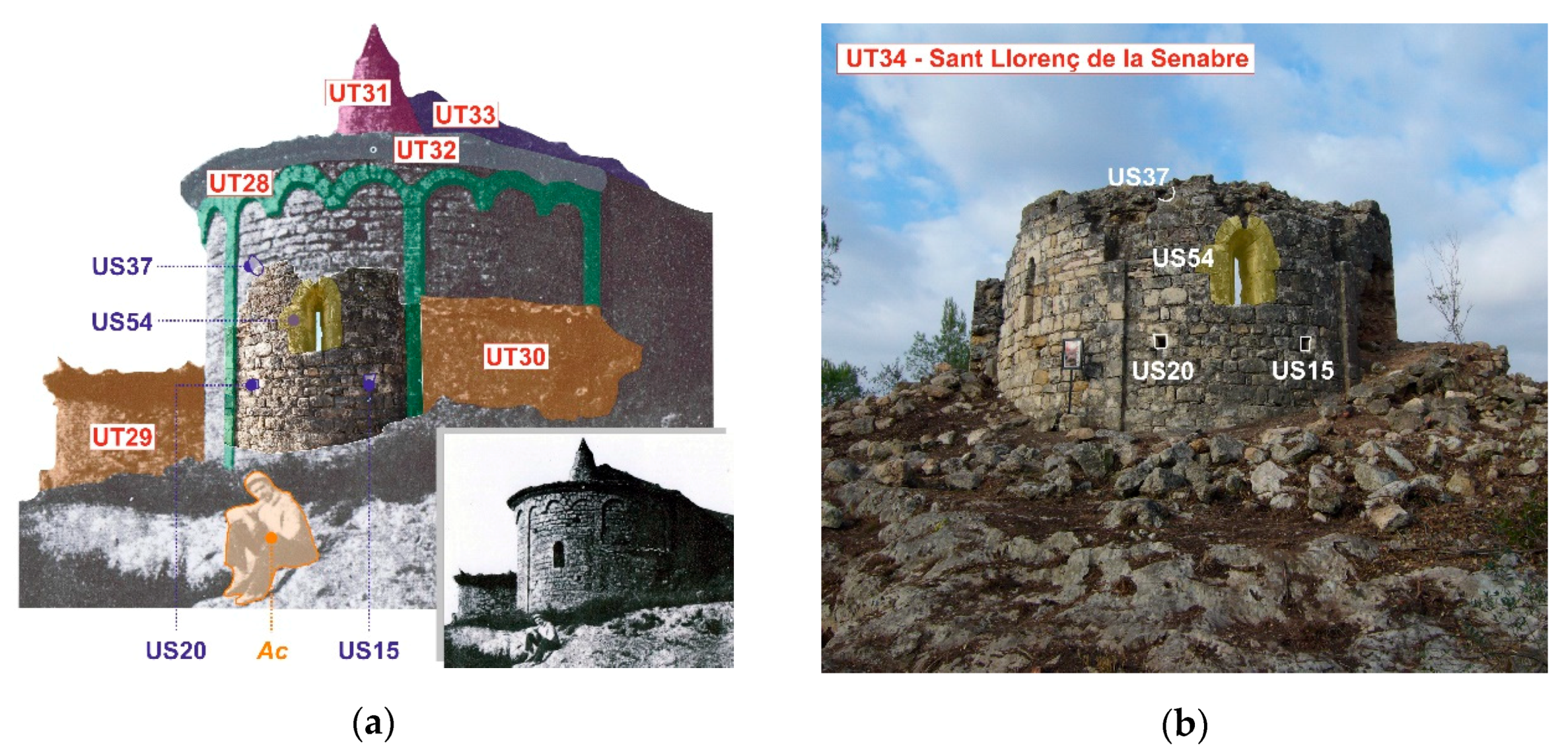
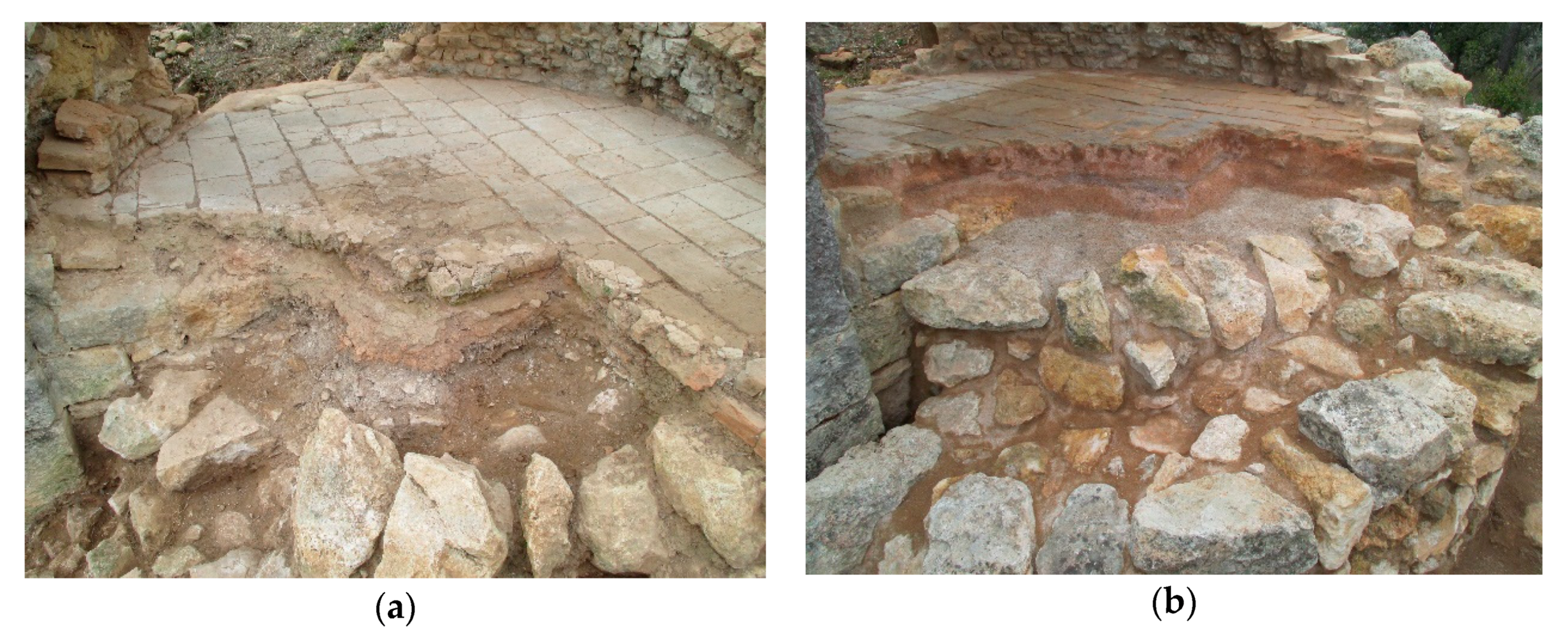


| Vestige | UT Id | UT Brief Description | Relationship(s) | Location | Biotic At | Anthropic Attributes | Date |
|---|---|---|---|---|---|---|---|
| Example A3 | 28 | Lombard bands | Attached to UT34 | = UT34 | Construction: Decoration | 1912 AD | |
| Example A3 | 29 | Annexe building | Attached to UT34 | = UT34 | Construction: Structure | 1912 AD | |
| Example A3 | 30 | Annexe building: Domestic oven | Attached to UT34 | = UT34 | Construction: Structure | 1912 AD | |
| Example A3 | 31 | Chimney | Affects UT34 | = UT34 | Construction: Structure | 1912 AD | |
| Example A3 | 32 | Apse roof | Onto UT34 | = UT34 | Construction: Structure | 1912 AD | |
| Example A3 | 33 | Nave roof | Onto UT34 | = UT34 | Construction: Structure | 1912 AD | |
| Example A3 | 34 | Sant Llorenç de la Senabre Romanesque church | Beneath: UT32, 33 Affected by: UT34 UT28, 29, 30 are attached | Santa Margarida i els Monjos (Barcelona, Spain) | Construction: Structure | 11th Cent AD | |
| Example A4 | 35 | Martorell | Includes: UT37, 38, 39, 40, 41 | Martorell (Catalonia, Spain) | Landscape: Place name | 1668 AD | |
| Example A4 | 36 | River Anoia | Passes by: UT35 | = UT35 | Watercourse | 1668 AD | |
| Example A4 | 37 | Bridge on the river Anoia | Affects: UT36 Included in: UT35 | = UT35 | Construction: Structure | 1668 AD | |
| Example A4 | 38 | Anoia’s Gate | Included in: UT35 | = UT35 | Construction: Structure | 1668 AD | |
| Example A4 | 39 | Church of Saint Mary | Included in: UT35 | = UT35 | Construction: Structure | 1668 AD | |
| Example A4 | 40 | Medieval Wall | Included in: UT35 | = UT35 | Construction: Structure | 1668 AD | |
| Example A4 | 41 | Town Buildings | Included in: UT35 | = UT35 | Construction: Structure | 1668 AD | |
| Example A4 | 42 | Royal Pathway | Passes by: UT35 | = UT35 | Landscape: Road | 1668 AD | |
| Example A5 | 43 | Company Guarro Casas’ School | Included in: UT47 Includes: UT45 Linked to: UT44, UT46 Engaged Ac21 | = UT47 | Activity: teaching | 1927 AD | |
| Example A5 | 44 | Old Mill Building | Linked to: UT43 | = UT47 | Construction: Structure | 1927 AD | |
| Example A5 | 45 | Teaching course | Included in: UT43 Performed by Ac21 | = UT47 | Activity: teaching | 1927 AD | |
| Example A5 | 46 | Company Guarro Casas | Linked to: UT43 | = UT47 | Activity: paper production | 1927 AD | |
| Example A5 | 47 | Gelida | Includes: UT43 | Gelida (Catalonia, Spain) | Landscape: Place name | 1927 AD |
| Vestige | Ac Id | Name | Job | Gender | Relationship(s) |
|---|---|---|---|---|---|
| Example A3 | - | unknown | unknown | Male | unknown |
| Example A5 | 21 | Josep Maria Roig | School teacher | Male | Ac-UT: Performs UT45; Ac-Ac: Teaches unknown Ac |
| Example A5 | - | unknown | unknown | Male | Ac-UT: Attends to UT45; Ac-Ac: Student of Ac21 |
| Example A5 | - | unknown | unknown | Female | Ac-UT: Attends to UT45; Ac-Ac: Student of Ac21 |
References
- Thibodeau, K. The Construction of the Past: Towards a Theory for Knowing the Past. Information 2019, 10, 332. [Google Scholar] [CrossRef]
- Shanks, M. Symmetrical Archaeology. World Archaeol. 2007, 39, 589–596. [Google Scholar] [CrossRef]
- López-Poza, S.; Algunas Reflexiones Sobre los Humanistas Digitales en España. In Humanidades Digitales Hispánicas. Available online: http://humanidadesdigitaleshispanicas.es/contribuciones/algunas-reflexiones-sobre-loshumanistas-digitales-en-españa/ (accessed on 1 March 2019).
- Martinón-Torres, M.; Killick, D.J. Archaeological theories and archaeological sciences. In Oxford Handbook of Archaeological Theory; Gardner, A., Lake, M., Sommer, U., Eds.; Oxford University Press: Oxford, UK, 2016; pp. 1–17. [Google Scholar]
- Hodder, I. The Entanglements of Humans and Things: A long-term view. New Lit. Hist. 2014, 45, 19–36. [Google Scholar] [CrossRef]
- Hicks, D. The material-cultural turn: Event and effect. In The Oxford Handbook of Material Culture Studies; Hicks, D., Beaudry, M.C., Eds.; Oxford University Press: Oxford, UK, 2010; pp. 25–98. [Google Scholar]
- Barceló, M. Arquelogia Medieval. En las Afueras del “Medievalismo”; Editorial Crítica: Barcelona, Spain, 1988. [Google Scholar]
- Zadora-Río, E. Le village des historiens et le village des archéologues. In Campagnes Médiévales. L’homme et son Espace. Études Offertes à Robert Fossier; Mornet, E., Ed.; Publications de la Sorbonne: París, France, 1995; pp. 145–153. [Google Scholar]
- Quirós-Castillo, J.A. Las Aldeas de los Historiadores y las Aldeas de los Arqueólogos en el Nordeste Peninsular. Territ. Soc. Poder 2007, 2, 65–86. [Google Scholar]
- Mauri, A.; Travé, E.; Del Fresno, P. An Integrated Implementation of Written and Material Sources–Conceptual Challenge and Technological Resources. In Archaeology. New Approaches in Theory and Techniques; Ollich, I., Ed.; InTech: Rijeka, Croatia, 2012; pp. 41–64. [Google Scholar]
- Witmore, C. The realities of the past: Archaeology, Object-Orientations, Pragmatology. In Modern Materials, Proceedings of the Contemporary and Historical Archaeology in Theory Conference, Oxford, UK, 2009; Fortenberry, B., McAtackney, L., Eds.; Archaeopress BAR International Series: Oxford, UK, 2012; pp. 25–36. [Google Scholar]
- Amati, V.; Munson, J.; Scholnick, J.; Habiba. Applying event history analysis to explain the diffusion of innovations in archaeological networks. J. Archaeol. Sci. 2019, 104, 1–9. [Google Scholar] [CrossRef]
- Mosca, A.; Rondelli, B.; Rull, G. The OBDA-Based ‘Observatory of Research and Innovation’ of the Tuscany Region. In Proceedings of the Joint Ontology Workshops 2017 (JOWO 2017), Episode 3: The Tyrolean Autumn of Ontology, Bozen-Bolzano, Italy, 21–23 September 2017. [Google Scholar]
- Mosca, A. Ontology-mediated Data Integration and Access in Research and Innovation Policy. In Proceedings of the Joint Ontology Workshops 2017 (JOWO 2017), Episode 3: The Tyrolean Autumn of Ontology, Bozen-Bolzano, Italy, 21–23 September 2017. [Google Scholar]
- Hodder, I.; Orton, C. Spatial Analysis in Archaeology; Cambridge University Press: Cambridge, UK, 1976. [Google Scholar]
- Interpreting Transformations of People and Landscapes in Late Antiquity and Early Middle Ages. In Archaeological Approaches and Issues; Diarte-Blasco, P., Christie, N., Eds.; Oxbow: Oxford, UK; Philadelphia, PA, USA, 2018. [Google Scholar]
- La Caracterització del Paisatge Històric; Bolós, J., Ed.; Universitat de Lleida: Lleida, Spain, 2010. [Google Scholar]
- Krauwer, S. The Parthenos Project. In Proceedings of the Parthenos CEE Workshop, Sofia, Bulgaria, 7–9 October 2019. [Google Scholar]
- Meghini, C.; Scopigno, R.; Richards, J.; Wright, H.; Geser, G.; Cuy, S.; Fihn, J.; Fanini, B.; Hollander, H.; Niccolucci, F.; et al. ARIADNE: A research infrastructure for archaeology. ACM J. Comput. Cult. Herit. 2017, 10, 1–27. [Google Scholar] [CrossRef]
- Yeo, G. The Conceptual Fonds and the Physical Collection. Archivaria 2012, 73, 43–80. [Google Scholar]
- Nesmith, T. Reopening Archives: Bringing New Contextualities into Archival Theory and Practice. Archivaria 2006, 60, 259–274. [Google Scholar]
- González-Pérez, C. A Conceptual Modeling Language for the Humanities and Social Sciences. In Proceedings of the Sixth International Conference on Research Challenges in Information Science (RCIS), Valencia, Spain, 16–17 May 2012. [Google Scholar]
- Gänser, G.; Michetti, G. InterPARES Trust Project. Ontology of Functional Activities for Archival Systems. TR05-Final Report-20180526. 2018. Available online: https://interparestrust.org (accessed on 16 March 2020).
- Mauri, A. Sistemes Territorials i L’estudi de les Traces Arqueològiques Medievals. Un Exemple D’aplicació a L’antiga Baronia de Castellvell de Rosanes (Baix Llobregat, Barcelona). Master’s Thesis, Universitat de Barcelona, Barcelona, Spain, 1997. [Google Scholar]
- Mauri, A. La Configuració del Paisatge Medieval: El Comtat de Barcelona Fins al Segle XI. Ph.D. Thesis, Universitat de Barcelona, Barcelona, Spain, 2006. [Google Scholar]
- Ivanovs, A.; Varfolomeyev, A. Editing an exploratory analysis of medieval documents bu means of XML technologies’. Humanit. Comput. Cult. Herit. 2005, 155, 155–160. [Google Scholar]
- de Jong, F.; Rode, H.; Hiemstra, D. Temporal language models for the disclosure of historical text. In Humanities, Computers and Cultural Heritage, Proceedings of the XVI International Conference of the Association for History and Computing; Koninklijke Nederlandse Academie van Wetenschappen: Amsterdam, The Netherlands, 2005; pp. 161–168. [Google Scholar]
- Mauri, A.; Travé, E.; Del Fresno, P. Research Information System (RIS): General principles and applications for Information Management. In Proceedings of the Open Science & the Humanities Conference, Barcelona, Spain, 21 June 2018. [Google Scholar]
- Del Fresno, P. Sistema de Información Arqueológica: Propuesta de Normalización, Desarrollo Conceptual e Informático. Ph.D. Thesis, Euskal Herriko Unibertsitatea–Universidad del País Vasco, Vitoria, Spain, 2016. [Google Scholar]
- Del Fresno, P.; Travé, E.; Mauri, A. Archaeological Research Information System (ARIS): Information and Stratigraphic Register Management. In Proceedings of the Open Science & the Humanities Conference, Barcelona, Spain, 21 June 2018. [Google Scholar]
- Travé, E.; López, M.D.; Casado, I.; Álvaro, K.; Marí, G. Research Information System (RIS): Study case for mercantile societies through the FENIX database. In Proceedings of the Open Science & the Humanities Conference, Barcelona, Spain, 21 June 2018. [Google Scholar]
- Travé, E.; Casado, I. Herramientas para el análisis contable de documentación mercantil bajomedieval: Perspectiva ontológica y gestión integrada de datos. In Actas del Congreso Mercados y Espacios Económicos en el Siglo XV. El Mundo del Mercader Torralba; López, M.D., Ed.; Publicacions de la Universitat de Barcelona: Barcelona, Spain, 2020. [Google Scholar]
- Arostegui, J. La Investigación Histórica: Teoría y Método; Crítica: Barcelona, Spain, 1995. [Google Scholar]
- Wickham, H. Tidy Data. J. Stat. Softw. 2014, 59, 1–23. [Google Scholar] [CrossRef]
- Harris, E.C. Principles of Archaeological Stratigraphy; Academic Press Inc.: San Diego, CA, USA, 1989. [Google Scholar]
- Gerritsen, A.; Riello, G. Introduction. Writing Material Culture History. In Writing Material Culture History; Gerritsen, A., Riello, G., Eds.; Bloomsbury Academic: London, UK, 2015; pp. 1–13. [Google Scholar]
- Johnson, T. Legal History and the Material Turn. In The Oxford Handbook of Legal History; Dubber, M.D., Tomlins, C.H., Eds.; University of Oxford: Oxford, UK, 2018; pp. 1–18. [Google Scholar] [CrossRef]
- Schouwenburg, H. Back to the Future? History, Material Culture and New Materialism. Hist. Cult. Mod. 2015, 3, 59–72. [Google Scholar] [CrossRef]
- Trentmann, F. Materiality in the Future of History: Things, Practices and Politics. J. Br. Stud. 2009, 48, 283–307. [Google Scholar] [CrossRef]
- Cosgrove, D. Landscape and Landschaft. Lecture delivered at the “Spatial Turn in History” Symposium. Ger. Hist. Inst. Bull. 2004, 35, 57–71. [Google Scholar]
- Graves, M.; Teulié, G. Histories of Space, Spaces of History–Introduction. E-rea Rev. Électron. D’études Monde Angloph. 2017, 14. Available online: http://erea.revues.org75878 (accessed on 28 March 2020).
- Torre, A. Un «tournant spatial» en histoire? Paysages, regards, ressources. Ann. Hist. Sci. Soc. 2008, 2008, 1127–1144. [Google Scholar]
- White, R. What is Spatial History? In Spatial History Lab: Working Paper; Standford University: Stanford, CA, USA, 2010. [Google Scholar]
- Carandini, A. Historias en la Tierra: Manual de Excavación Arqueológica; Crítica: Barcelona, Spain, 1997. [Google Scholar]
- SigArq. Sistema de Información Geoespacial Arqueológico. Available online: http://www.sigarq.es/home/ (accessed on 9 December 2019).
- Soler, M. Feudalisme i nucleació poblacional. Processos de concentració de l’habitat al comtat de Barcelona entre els segles X i XIII. Acta Hist. Archeol. Med. 2002, 2002, 69–101. [Google Scholar]
- Travé, E. Los hornos medievales y la cerámica negra. In Actas del XIX Congreso de la Asociación de Ceramología. Obra Negra y Alfarería de Cocina; Asociación de Ceramología/Ajuntament de Quart: Quart, Spain, 2017; pp. 123–147. [Google Scholar]
- Information and Documentation—Work Process Analysis for Records; ISO/TR 26122; ISO: Geneva, Switzerland, 2008.
- Information and Documentation—Records Management—Part 1: Concepts and Principles; ISO 15489-1; ISO: Geneva, Switzerland, 2016.
- International Council on Archives. ISAD(G) (General International Standard Archival Description) Norma Internacional General de Descripció ARXIVÍSTICA; Associació d’Arxivers de Catalunya/Generalitat de Catalunya Departament de Cultura: Barcelona, Spain, 2001. [Google Scholar]
- Wilkinson, M.D. The FAIR Guiding Principles for scientific data management and stewardship. Sci. Data 2016, 3, 160018. [Google Scholar] [CrossRef]
- Parthenos. Guidelines to FAIRify Data Management and Make Data Reusable. Available online: https://zenodo.org/record/2668479 (accessed on 16 March 2020).
- Yan, J.; Wang, C.H.; Cheng, W.; Gao, M.; Zhow, A. A retrospective of Knowledge Graphs. Front. Comput. Sci. 2018, 12, 55–74. [Google Scholar] [CrossRef]
- Manrique, R.; Pereira, B.; Mariño, O. Exploring knowledge graphs for the identification of concept prerequisites. Smart Learn. Environ. 2019, 6, 21. [Google Scholar] [CrossRef]
- Ehrlinger, L.; Wöess, W. Towards a Definition of Knowledge Graphs. Conference Paper. SEMANTiCS 2016, 48, 1–5. [Google Scholar]
- Mauri, A.; Travé, E.; Del Fresno, P. Estudi preliminar de l’ermita de Sant Llorenç de la Senabre. Santa Margarida i els Monjos (Alt Penedès). In III Monografies del Foix; Diputació de Barcelona: Barcelona, Spain, 2013; pp. 150–157. [Google Scholar]
- Del Fresno, P.; Socorregut, J. Conèixer, gestionar i difondre: El forn de l’ermita de Sant Llorenç de la Senabre. Santa Margarida i els Monjos (Alt Penedès). In IV Trobada d’estudiosos del Foix; Diputació de Barcelona: Barcelona, Spain, 2017; pp. 144–153. [Google Scholar]
- Puig, P. El monestir de Sant Llorenç del Munt Sobre Terrassa. Diplomatari dels Segles X i XI. Volum I; Fundació Noguera: Barcelona, Spain, 1995. [Google Scholar]
- ANC1-690-T-721, f8v. Edited by Benavides, J. Para una Historia de las Sociedades Mercantiles Catalanas. Estudio Completo del “Dietari Honzè” de la Compañía Torralba (10 de mayo del 1434–Agosto del 1437). Ph.D. Thesis, Universitat de Barcelona, Barcelona, Spain, 2017.
- Vidal, E. La conca del riu Foix i sos principals afluents. Butll. Centre Excursion. Catalunya 1912, 206, 65–79. [Google Scholar]
- Magalotti, L. Viaje de Cosme de Médicis por España y Portugal (1668–1669); Sanchez Rivero, A., Mariutti, A., Eds.; Sucesores de Rivadeneyra: Madrid, Spain, 1933. [Google Scholar]
- Vinyes, J.M.; Carafí, E.; Rovira, R. Guarro Casas. 300 anys D’història. 1698–1998; Guarro Casas: Barcelona, Spain, 1998; p. 102. [Google Scholar]
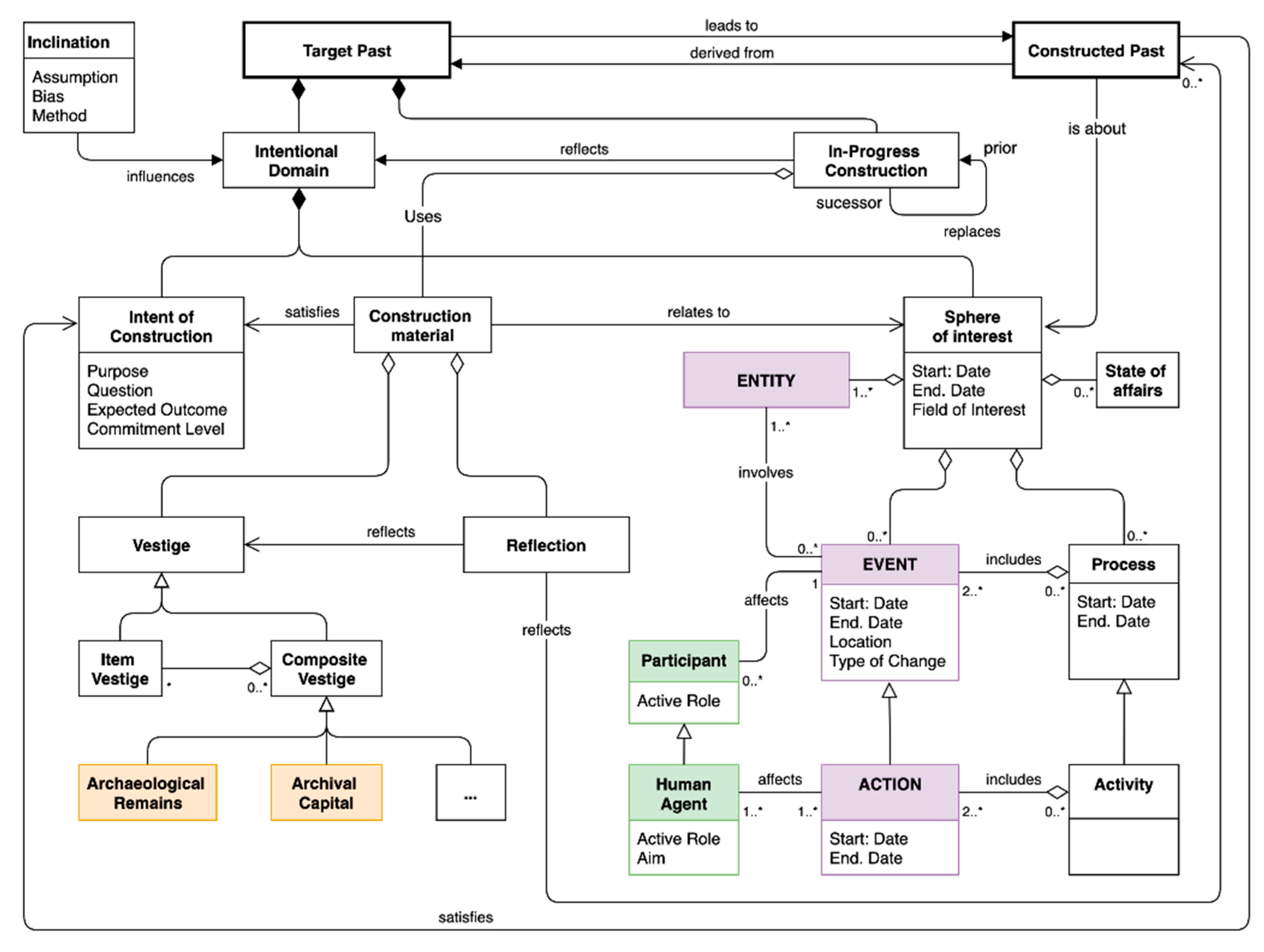
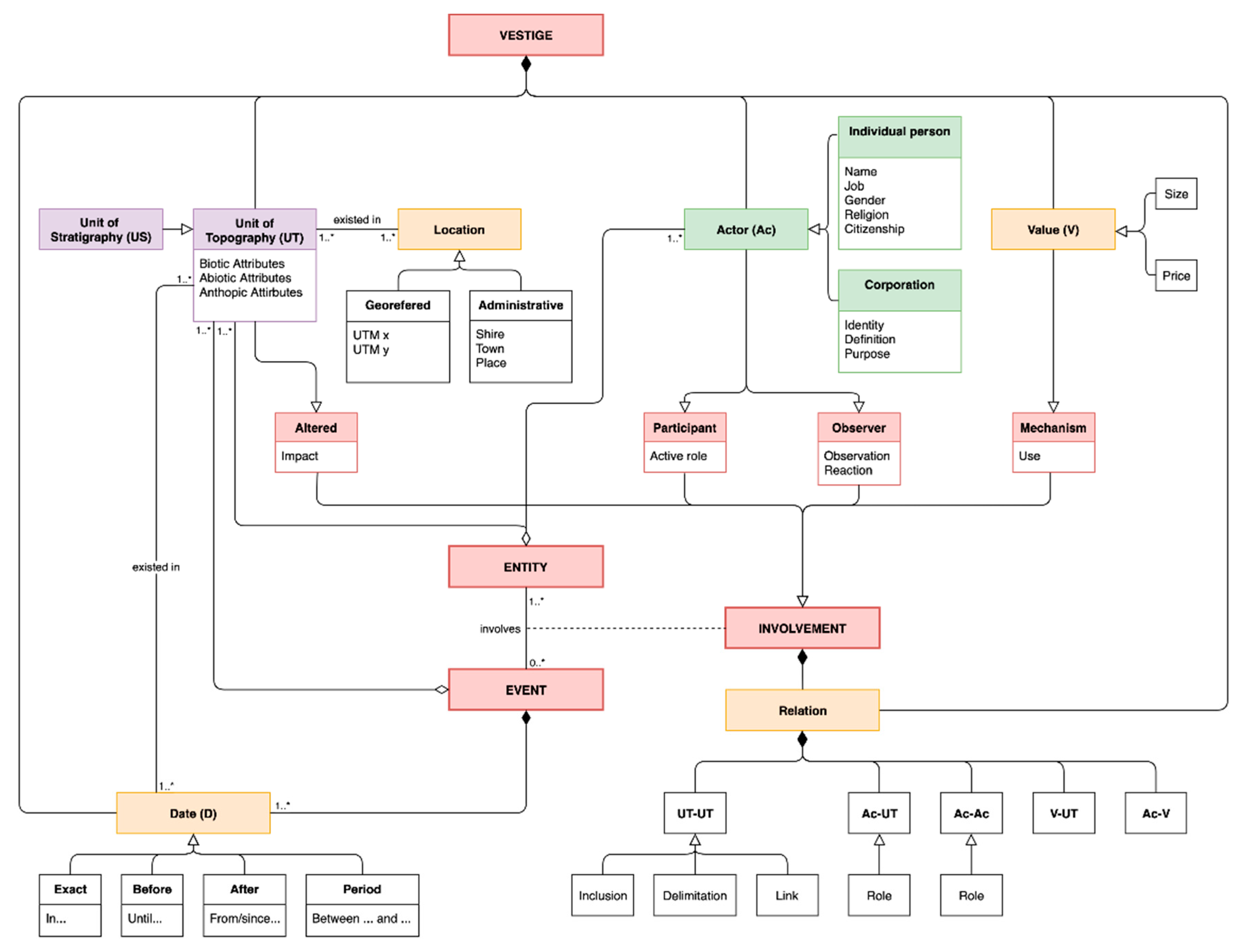
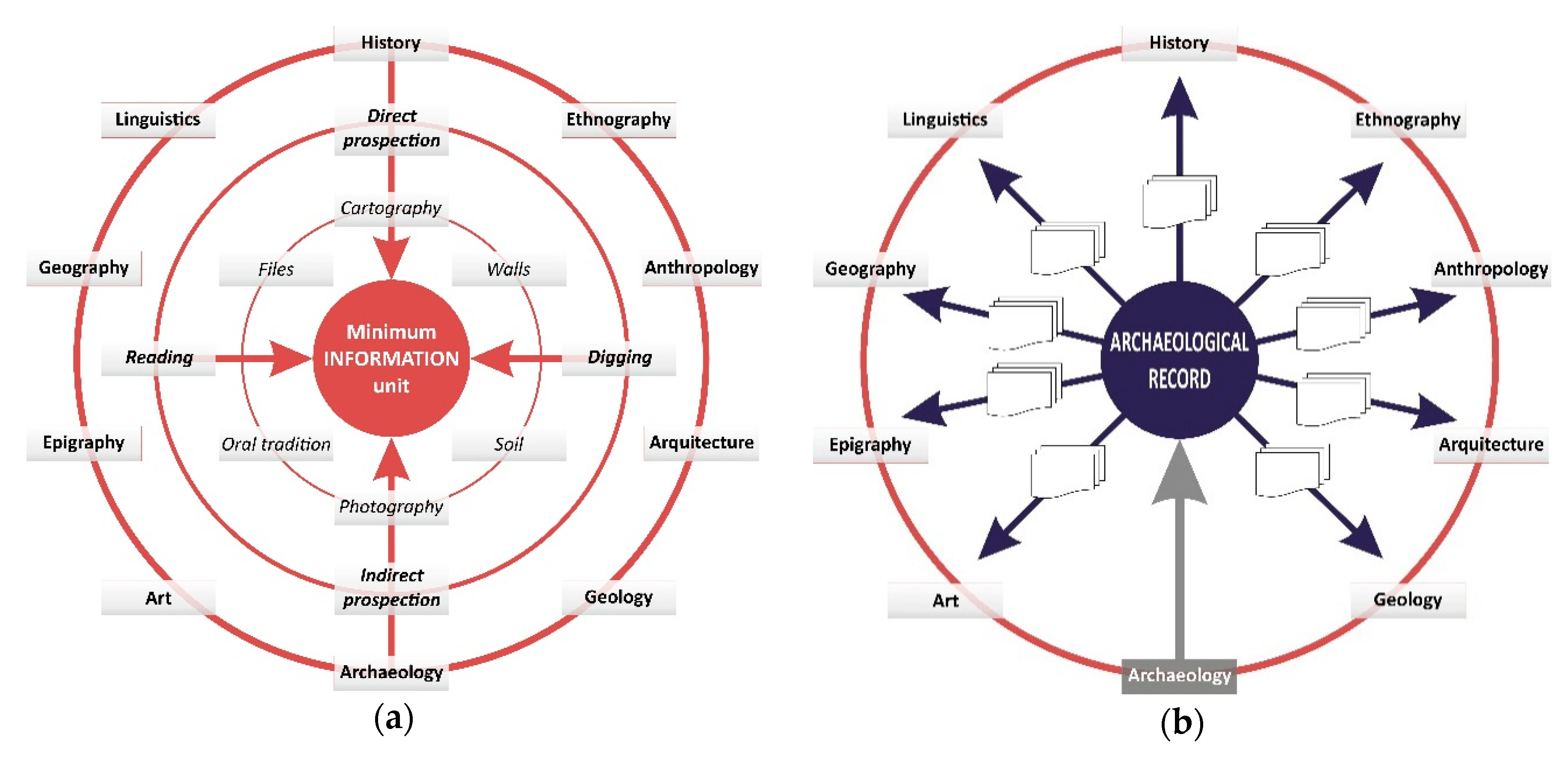
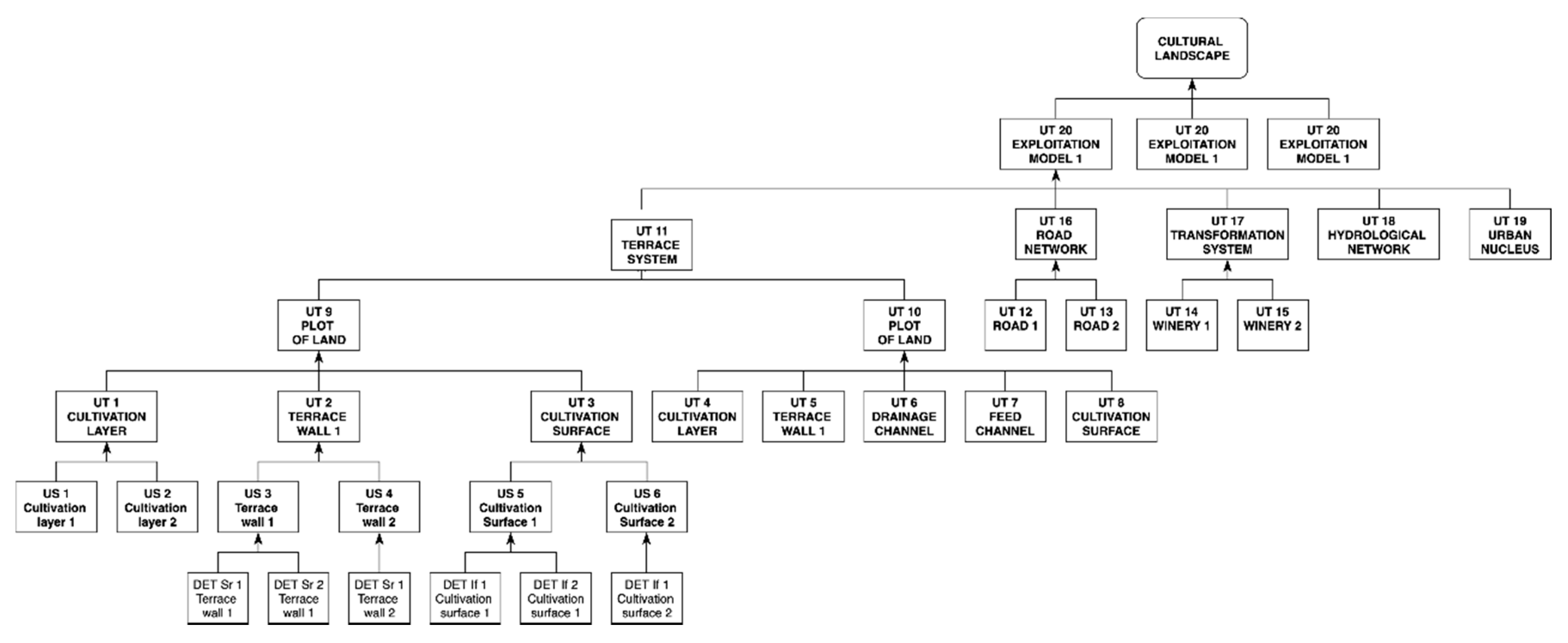
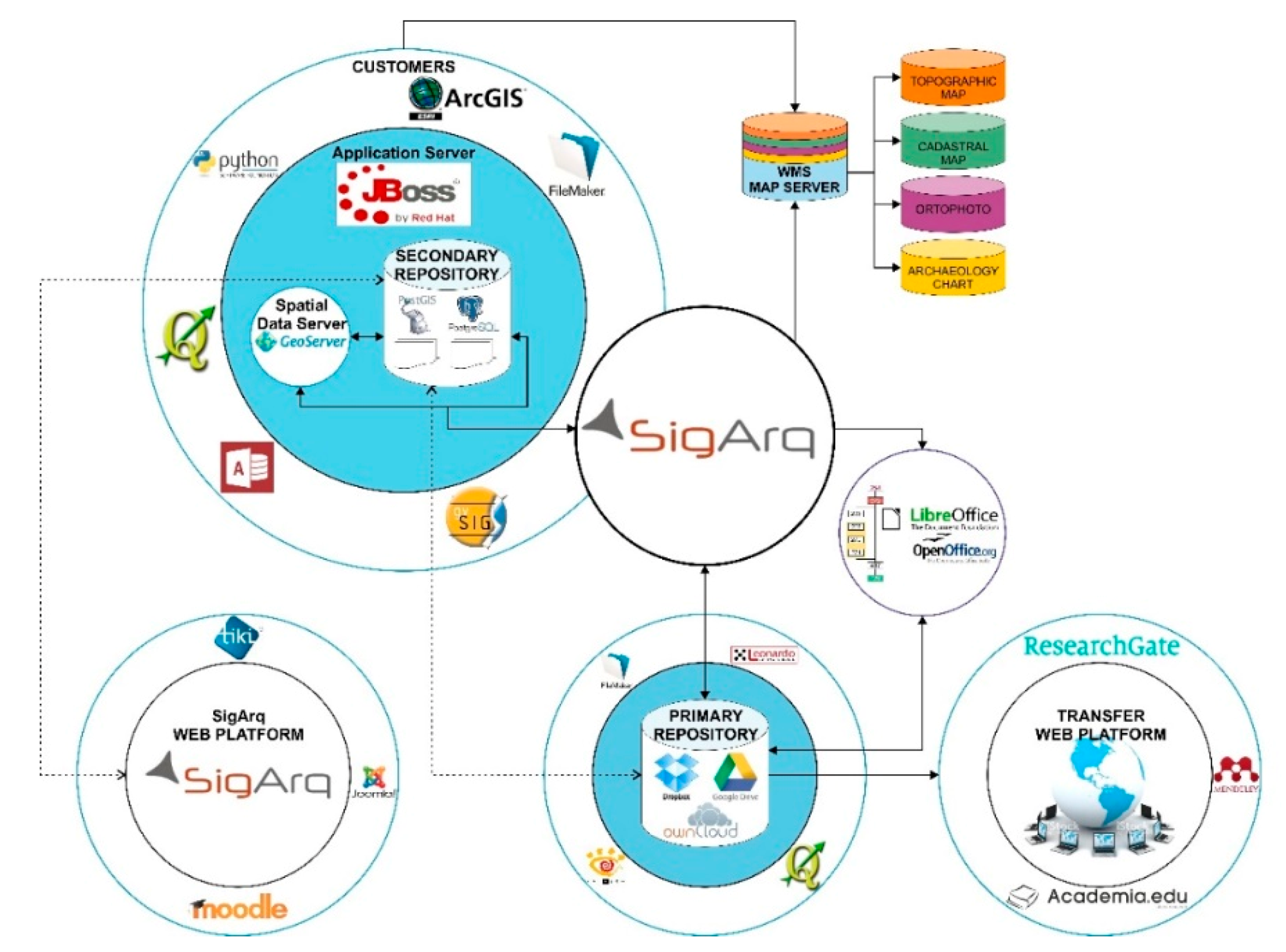
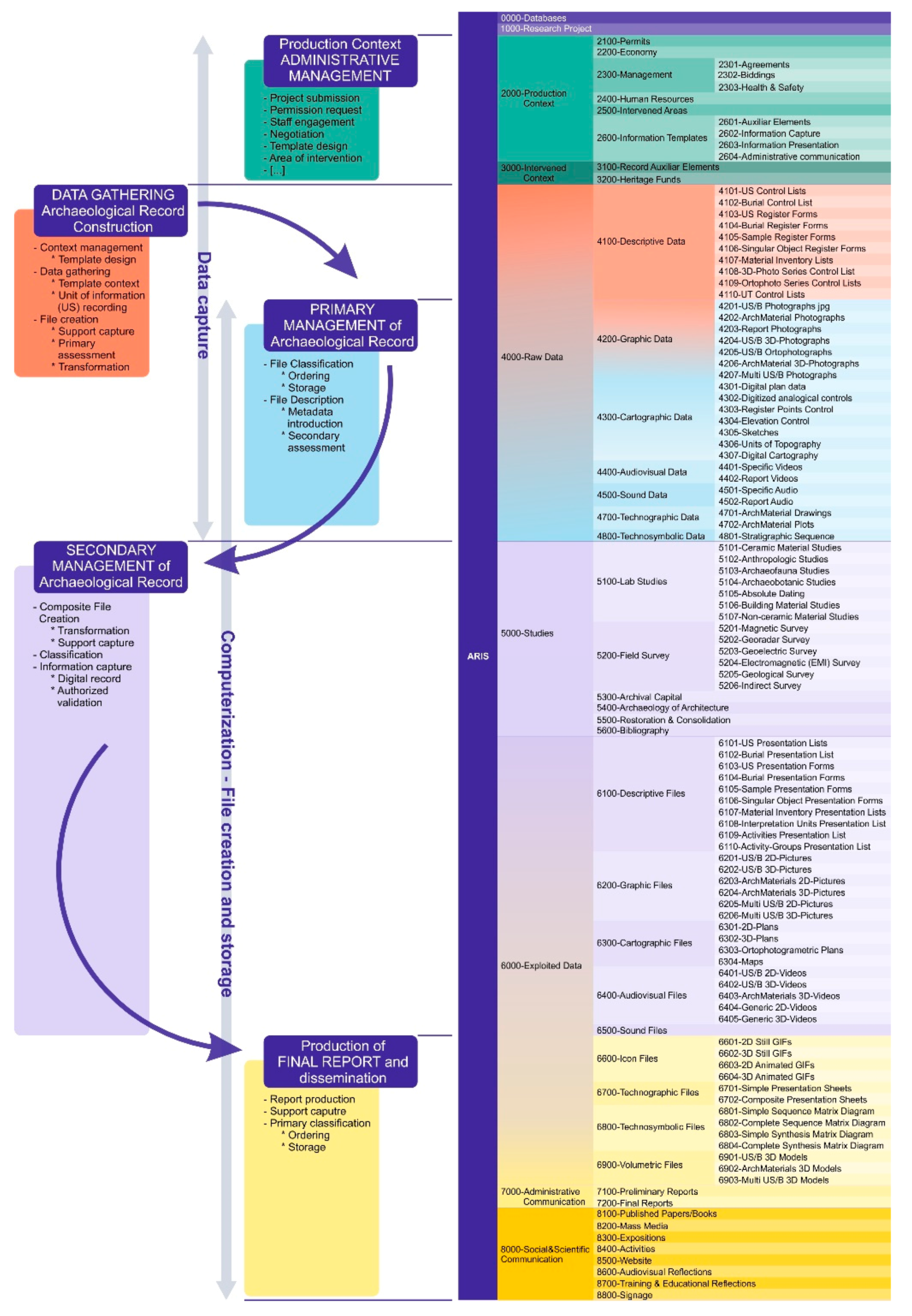
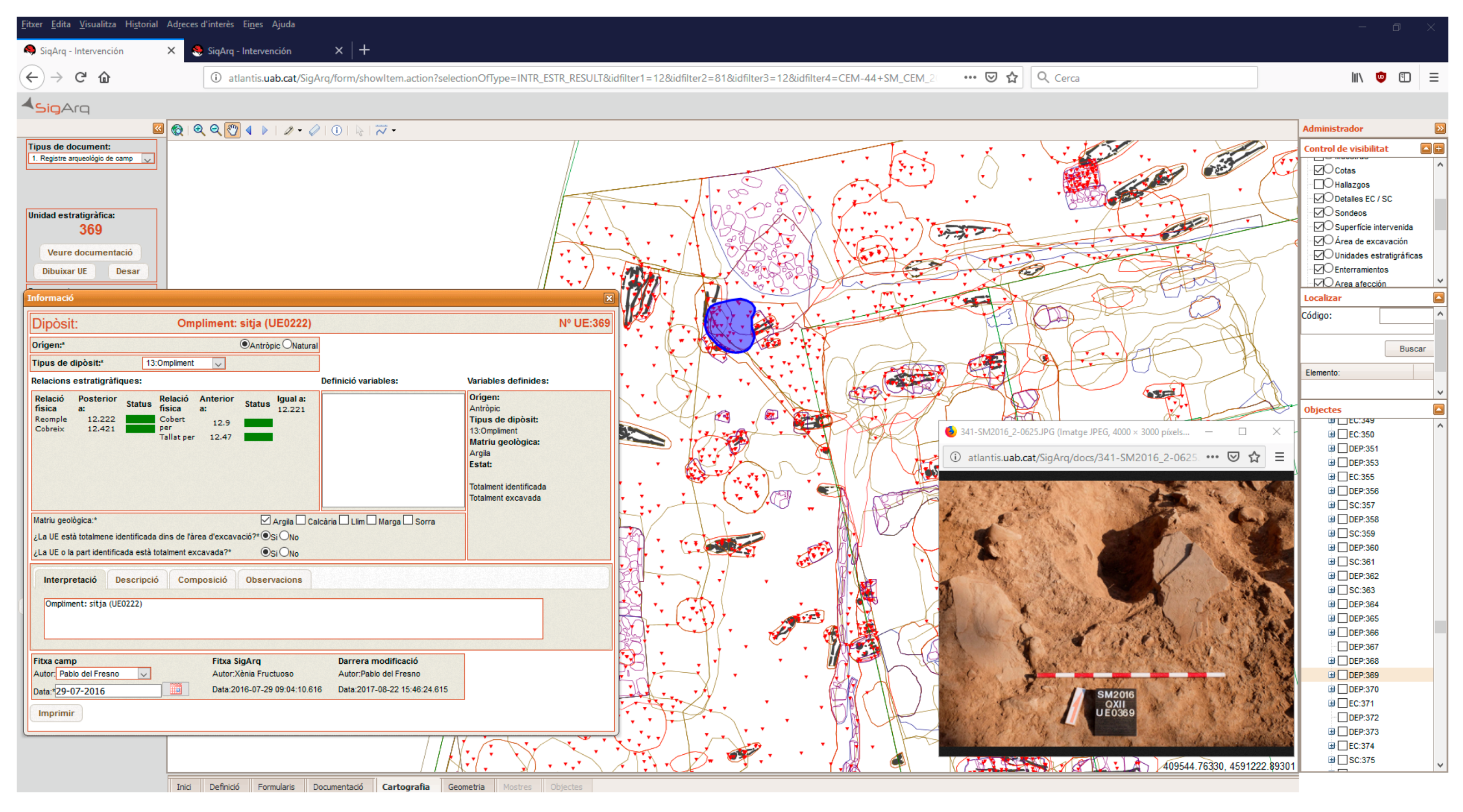
| ARIS | |||
|---|---|---|---|
| Function | Activity | File | Item |
| 4000-Raw Data | 4200-Graphic Data | 4201-US/B Photographs .jpg | 4201-XXXAAAA-000N.FFF 1 |
| 4202-ArchMaterial Photographs | 4202-XXXAAAA-000N.FFF | ||
| 4203-Report Photographs | 4203-XXXAAAA-000N.FFF | ||
| […] | […] | ||
| Group | Field | Character 2 | Indications for Users and Format | |
|---|---|---|---|---|
| Legend | Title | O | Picture caption describing the content: <text> | |
| Special instructions | O | Instructions for further processing or considerations to take into account (e.g., labeling mistakes if any): <text> | ||
| Key words | Key words | C | G | Archaeological site ID expression: <AAA> |
| C | G | Year of fieldwork campaign: <0000> | ||
| C | G | Trench: <III> | ||
| C | S | US ID number: <US0000> | ||
| C | S | Burial ID number: <B000> | ||
| C | SA | For pictures with plan indications: <photopla> | ||
| C | SA | For drone-obtained aerial views: <photodrone> | ||
| C | SA | For SigArq uploading (one per US): <photoSig> | ||
| C | SA | […] | ||
| Credits | Author | O | <Surname(s), Name>; <ORCID> | |
| Origin | C | G | <Institution or Company Name> | |
| Copyright | C | G | CC (by-nc-sa) | |
| Contact | C | G | <e-mail address> | |
| Date/Time | Creation date | C | G | <yyyy/mm/dd> |
| Origin | City | C | G | <City name> |
| Location | C | G | <Location name> | |
| State/province | C | G | <State/province name> | |
| Country | C | G | <Country name> | |
| Attribute | US | UT |
|---|---|---|
| Source of obtention | Material | Written, material, visual, sound |
| Materiality | Essential | Non-essential |
| Informative dimensions: | ||
| • SPATIAL | Essential | Essential |
| • Descriptive | Essential | Essential |
| • Graphic | Essential | Non-essential |
| • Cartographic | Essential | Non-essential |
| • TEMPORAL | Essential | Essential |
| Possible relations: | ||
| • US-US/UT-UT | Physical contact | Inclusion, delimitation, link |
| • Ac-US/Ac-UT | Non-possible 1 | Non-essential |
| • US-UT | US = UT US + US = UT | US = UT UT + UT = UT |
| Involvement in event | Essential (altered) | Non-essential |
© 2020 by the authors. Licensee MDPI, Basel, Switzerland. This article is an open access article distributed under the terms and conditions of the Creative Commons Attribution (CC BY) license (http://creativecommons.org/licenses/by/4.0/).
Share and Cite
Travé Allepuz, E.; del Fresno Bernal, P.; Mauri Martí, A. Ontology-Mediated Historical Data Modeling: Theoretical and Practical Tools for an Integrated Construction of the Past. Information 2020, 11, 182. https://doi.org/10.3390/info11040182
Travé Allepuz E, del Fresno Bernal P, Mauri Martí A. Ontology-Mediated Historical Data Modeling: Theoretical and Practical Tools for an Integrated Construction of the Past. Information. 2020; 11(4):182. https://doi.org/10.3390/info11040182
Chicago/Turabian StyleTravé Allepuz, Esther, Pablo del Fresno Bernal, and Alfred Mauri Martí. 2020. "Ontology-Mediated Historical Data Modeling: Theoretical and Practical Tools for an Integrated Construction of the Past" Information 11, no. 4: 182. https://doi.org/10.3390/info11040182
APA StyleTravé Allepuz, E., del Fresno Bernal, P., & Mauri Martí, A. (2020). Ontology-Mediated Historical Data Modeling: Theoretical and Practical Tools for an Integrated Construction of the Past. Information, 11(4), 182. https://doi.org/10.3390/info11040182






